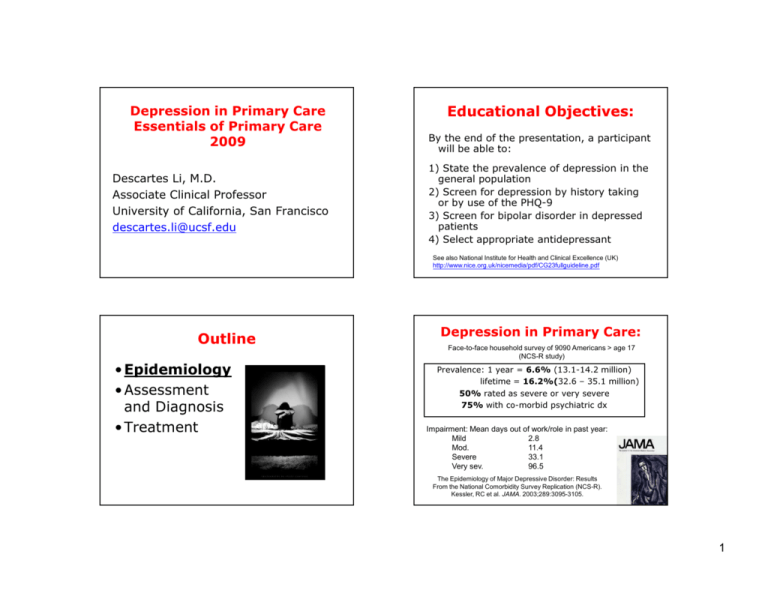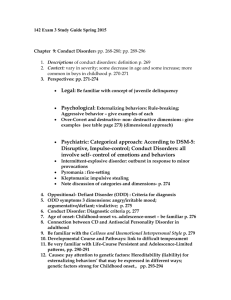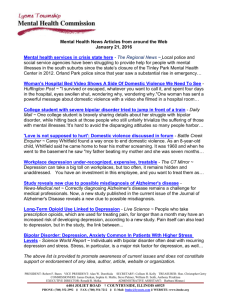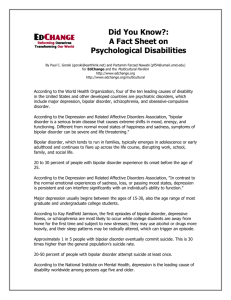Managing Depression in Primary Care
advertisement

Depression in Primary Care Essentials of Primary Care 2009 Descartes Li, M.D. Associate Clinical Professor University of California, San Francisco descartes.li@ucsf.edu Educational Objectives: By the end of the presentation, a participant will be able to: 1) State the prevalence of depression in the general population 2) Screen for depression by history taking or by use of the PHQ-9 3) Screen for bipolar disorder in depressed patients 4) Select appropriate antidepressant See also National Institute for Health and Clinical Excellence (UK) http://www.nice.org.uk/nicemedia/pdf/CG23fullguideline.pdf Outline • Epidemiology • Assessment and Diagnosis • Treatment Depression in Primary Care: Face-to-face household survey of 9090 Americans > age 17 (NCS-R study) Prevalence: 1 year = 6.6% (13.1-14.2 million) lifetime = 16.2%(32.6 – 35.1 million) 50% rated as severe or very severe 75% with co-morbid psychiatric dx Impairment: Mean days out of work/role in past year: Mild 2.8 Mod. 11.4 Severe 33.1 Very sev. 96.5 The Epidemiology of Major Depressive Disorder: Results From the National Comorbidity Survey Replication (NCS-R). Kessler, RC et al. JAMA. 2003;289:3095-3105. 1 Depression in Primary Care: The Depressing Reality • 52% of Community Cases Received any Treatment • Treatment, when Received, was “Minimally Adequate” in only 42% • Thus, only 22% of all Cases were Adequately Treated (ie, 42% of 52%) The Epidemiology of Major Depressive Disorder: Results From the National Comorbidity Survey Replication (NCS-R). Kessler, RC et al. JAMA. 2003;289:3095-3105. (Disability Adjusted Life Years) Disease Burden by Illness - DALY United States, Canada and Western Europe, 2000 1515-44 year olds Unipolar depressive disorders Alcohol use disorders Schizophrenia Iron--deficiency anemia Iron Bipolar affective disorder Hearing loss, adult onset HIV/AIDS Chronic OPD Osteoarthritis Road traffic accidents 0 2 4 6 8 10 12 Percent of Total Source: WHO – World Health Report, 2001 Depression: A Global Perspective Leading cause of disability as measured by YLDs (Years Lived with Disability) 4th leading contributor to the global burden of disease (DALYs) in 2000. By 2020, projected to reach 2nd place of the ranking of DALYs calculated for all ages, both sexes. Currently, the 2nd cause of DALYs in the age category 15-44 years for both sexes combined. http://www.who.int/healthinfo/global_burden_disea se/2004_report_update/en/index.html Global Burden of Disease Major depression will have worldwide second rank order among the 15 leading causes of disability (DALY’s) in 2020 Murray CJL & Lopez AD WHO, Harvard SPH & Worldbank (1996) 2 Outline • Epidemiology • Assessment and Diagnosis –Diagnostic criteria –Screening techniques –Rule out bipolar disorder • Treatment Major Depressive Disorder —Diagnostic Criteria Five or more of the following symptoms are present most of the day, nearly every day, during a period of at least 2 consecutive weeks At least 1 of these 2 symptoms: 1. Depressed mood 2. Loss of interest or pleasure in all, or almost all, usual activities Symptoms must cause clinically significant distress or impairment in social, occupational, or other important areas of functioning DSM-IV-TR™ 2000. Major Depressive Disorder —Diagnostic Criteria Five or more of the following symptoms are present most of the day, nearly every day, during a period of at least 2 consecutive weeks 3. Significant weight loss or weight gain 4. Insomnia or hypersomnia 5. Psychomotor agitation or retardation 6. Fatigue or loss of energy 7. Feelings of worthlessness or excessive or inappropriate guilt 8. Diminished ability to think or concentrate or indecisiveness 9. Recurrent thoughts of death or suicide Major Depressive Episode: SIG E CAPS criteria Depressed mood (or anhedonia), plus: • S –Sleep symptoms • I—lack of Interest. • G—feelings of Guilt • E—lack of Energy. • C--lack of Concentration. • A--lack of Appetite. • P--Psychomotor changes • S--thoughts of Suicide DSM-IV-TR™ 2000. 3 Case Vignette#1 (continued) Case Vignette#1 A 41-year-old woman with recent diagnosis of systemic lupus erythematosus presents in your outpatient clinic with depression for 4 weeks. She reports 5 pound weight loss, little energy or interest in life, poor sleep, feelings of worthlessness/hopelessness, and thoughts of death and suicide. She has been taking prednisone 80mg daily for the past four weeks with partial improvement of her lupus symptoms. Her husband reports that her current depressive symptoms are very similar to the ones she experienced three years earlier when she was hospitalized for depression. Case Vignette#1 (continued) Case Vignette#1 (continued) Which ONE of the following diagnoses is LEAST likely? 67% 9% 9% M A dj us tm en tR ea aj . .. or de pr es M si oo . .. d D is or de Su r. bs .. ta nc ein Su du bs . .. ta nc e ab us ... a) Adjustment Reaction with Depressed Mood b) Major depressive disorder, recurrent c) Mood Disorder Due to a General Medical Condition with Depressive Features d) Substance-induced Mood Disorder6% 9% with Depressive Features e) Substance abuse Discussion: a. Adj rxn – recent diagnosis of SLE b. MDD – this could be a recurrence c. Due to a General Medical Condition– SLE involves CNS d. Substance-induced Mood Disorder – corticosteroids generally cause euphoria, but can cause depression e. Substance abuse – common things are common 4 Outline Depression: Assessment • Epidemiology • Assessment and Diagnosis –Diagnostic criteria –Screening techniques –Rule out bipolar disorder • Treatment Depression in Primary Care: 2 Simple Screening Questions: • “During the past 2 weeks, have you felt down, depressed or hopeless?” • “During the past 2 weeks, have you felt little interest or pleasure in doing things?” The Three S’s of the Psychiatric Interview 1) S – Stressors/triggers 2) S – Suicidality 3) S – Substance Abuse The US Preventive Services Task Force JAMA, June 18, 2003- Vol 289 (23) 5 Diagnosis of Depression Key issues 1) Rule out Medical conditions causing psychiatric symptoms 2) Rule out Substance abuse or iatrogenic medications 3) Rule out Bipolar disorder (ie, screen for mania or hypomania) Physical Health Questionnaire9, depression scale • Nine (9) items • Easy to score • There are two components of the PHQ-9: –Diagnostic –Severity • Google: “PHQ-9” http://www.depression- primarycare.org/clinicians/toolkits/materials/forms/phq9/ Beyond the psychiatric interview • Physical Health Questionnaire-9, depression scale, aka PHQ-9 • Mood Disorder Questionnaire Case Vignette#2 Three weeks ago, a 59yo Caucasian woman with a history of CHF, depression, and alcohol abuse presents to your office with three months of depressed mood. At that time, you started her on citalopram 20mg at bedtime. She has been on hydrochlorothiazide and potassium supplements for over one year. 6 Case Vignette#2 Initiation of divalproex 500mg qhs Increase citalopram to 40mg daily Stop citalopram Trial of quetiapine 50mg daily Urine toxicology screen ... olo to xic . ti. .. lo fq ue rin e U ci ta lo pr a.. ... of a. Divalproex is the preferred treatment for bipolar disorder in patients with potential electrolyte and fluid shifts. b. If this patient is having a mixed episode, antidepressants may be the cause and are therefore contraindicated c. Stopping citolapram is probably the most appropriate intervention d. Low-dose atypical antipsychotics can target insomnia, racing thoughts, and agitation. e. Urine toxicology screen is indicated to rule out substance abuse. In cr ea se In iti at io n Case Vignette#2 Answers Discussed 26% 16% 7% cit al ... 7% 45% Tr ia a) b) c) d) e) Which ONE of the following interventions is MOST appropriate? St op Today in your office, she describes improved energy but significantly worsened irritability and insomnia, with new onset hyperactivity, racing thoughts, and impulsivity. She also endorses ruminative suicidal thoughts. Case Vignette#2 Question Outline • Epidemiology • Assessment and Diagnosis –Diagnostic criteria –Screening techniques –Rule out bipolar disorder • Treatment 7 Rule out Bipolar Disorder Major Depressive Disorder • Issue: antidepressants may worsen the course of bipolar disorder • How common is bipolar disorder in primary care? • Screen for mania or hypomania in all patients with depression Dysthymic Disorder Cyclothymic Disorder Bipolar I Disorder Bipolar II Disorder Bipolar Disorder in Primary Care Bipolar Disorder in Patients with Anxiety and depression – Of 108 consecutive anxious and depressed patients in primary care clinic, A 56-year-old man comes to you with a chief complaint of anxiety and depression. What is the likelihood that he has bipolar disorder? 33% 1% 5% 10% 25% 50% – 25% were diagnosed with bipolar disorder: BP I (2.8%), BP II (18.5%), BP III (3.7%) 31% 20% 9% 50 % 25 % 10 % 5% 7% 1% a) b) c) d) e) – Using DSM-IV criteria in a semi-structured interview by family physician, Manning JS et al. Compr Psychiatry 1997; 38: 102-108. On the Nature of Depressive and Anxious States in a Family Practice Setting: The High Prevalence of Bipolar II and Related Disorders in a Cohort Followed Longitudinally. 8 Bipolar Disorder: DIG FAST D – Distractibility I – Insomnia G – Grandiosity (or inflated self esteem) F – Flight of Ideas (or racing/crowded thoughts) A – Activities (increased goal directed activities) S- Speech (pressured) T- Thoughtlessness (impulsivity, ie, increased pleasurable activities with potential for negative consequences: sex, money, traveling, driving) Antidepressants are generally contraindicated in bipolar disorder •Generally have NOT been shown to be effective in bipolar depression •May trigger mania or hypomania •May trigger rapid cycling or mixed episode Mood Disorders Questionnaire • Self-administered, one-page questionnaire (see attached at end of syllabus) • 7 or more positive responses is a positive screen Hirschfeld RM et al. Validity of the Mood Disorder Questionnaire: A General Population Study. (Am J Psychiatry 2003; 160:178–180) Hirschfeld RM et al. Development and Validation of a Screening Instrument for Bipolar Spectrum Disorder: The Mood Disorder Questionnaire. (Am J Psychiatry 2000; 157:1873–1875) Outline • Epidemiology • Assessment and Diagnosis • Treatment –Psychotherapy –Medications Sachs, GS et al. Effectiveness of adjunctive antidepressant treatment for bipolar depression. NEJM 2007 356 17:1711 -22. 9 Depression Treatment Algorithm Psychotherapy of Depression Psychodynamic psychotherapy • unconscious content of a client's psyche causes depression • more brief and less intensive than psychoanalysis • relies on the interpersonal relationship between client and therapist Outline • Epidemiology • Assessment and Diagnosis • Treatment –Psychotherapy –Medications Psychotherapy of Depression Interpersonal Psychotherapy (IPT) • time-limited, manualized, supported by RCTs • based on the belief that interpersonal factors contributes to depression • focuses interpersonal problems 10 Psychotherapy of Depression Behavior Therapy Treatment is directed at having the individual desensitize to avoided stimuli through exposure and other behavioral interventions (behavioral activation, exercise) Internal mental states are relatively unimportant. Self-Help Books for Depression Cognitive-behavioral • Feeling Good, by David Burns • Mind Over Mood, by Greenberger and Padefsky Psychotherapy of Depression Cognitive Therapy Depression conceptualized as arising from cognitive distortions. Thus, treatment is directed at changing unproductive or intrusive thought patterns. The individual examines his or her feelings and learns to separate realistic from unrealistic thoughts. Cognitive-Behavioral Therapy (CBT) Combination of cognitive and behavior therapies. Supported by RCTs Outline • Epidemiology • Assessment and Diagnosis • Treatment –Psychotherapy –Medications •Overview •How to choose •Management 11 Medications • SSRI’s • “Other” Antidepressants • Tricyclics • MAOI’s SSRI’s (selective serotonin reuptake inhibitors) • First line • Fairly safe in OD • Recommend 9m minimum duration of treatment Hx: 3-Phenoxy-3-phenylpropylamine, a compound structurally similar to diphenhydramine, was taken as a starting point to make a chemical compound that would inhibit serotonin reuptake Fluoxetine (Prozac), sertraline (Zoloft), paroxetine (Paxil), fluvoxamine (Luvox), citalopram (Celexa), escitalopram (Lexapro) SSRI: Side Effects • long term: – Can be “deal-breakers” – Frequently do not resolve until medication is stopped – weight gain (moderate), sexual side effects (in around 35%) • short term: – Generally more transient and mild, though occas. may be intolerable – nausea, diarrhea, headache, rash, insomnia, sweating SSRI: Side Effects serotonin syndrome: usually in combo with two or more serotonergic agents -restlessness confusion, flushing, tremor progressing to hyperthermia, hypertonicity, rhabdomyolysis, death suicide controversy: in 2004, black box on SSRI and other antidepressants warning of increased risk of suicidality in patients younger than 24. However, decrease in ssri prescriptions may have resulted in increased suicide rates in this population. [Am J Psychiatry 164 (9): 1356–63] 12 Other Antidepressants • Buproprion (Wellbutrin): – low rate of sexual side effects or wt gain, – Assoc. w/ increased rate of seizures, not for pts w/ eating d/o or prior sz d/o • Duloxetine (Cymbalta): – mixed NE and 5HT activity, – Alleviate pain of diabetic neuropathy and fibromyalgia? • Mirtazapine (Remeron): – sedation and weight gain Other Antidepressants • Nefazodone (Serzone): – 5-HT2 blocker, ?for anxious depression – black box for liver failure (1/250K pt-yrs) – low rate of sexual se’s • Trazodone (Desyrel): – usually prescribed as a hypnotic – Warn about priapism • Venlafaxine (Effexor): – – – – Mixed NE and 5HT activity increases BP similar side effect profile to ssri’s significant withdrawal syndrome Tricyclic Antidepressants (TCA’s ) • NE reuptake inhibitors • anticholinergic side effects, orthostatic hypotension, tremor, weight gain, sexual side effects, • cardiac conduction delay (quinidine like effect) Note: Duloxetine, a newer “dual action” antidepressant, has more equal 5HT and NE effects across its dosage range. Examples [not a complete list]: amitriptyline (Elavil), doxepin (Sinequan), imipramine (Tofranil), desipramine (Norpramin), nortriptyline (Pamelor, Aventyl), maprotiline (Ludiomil) 13 Monoamine-oxidase inhibitors (MAOIs) Important: dietary restrictions! (b/o hypertensive crisis) Also drug-drug interactions, including OTCs: ephredine, pseudoephredine, meperidine (Demerol) Side effects: sedation, sexual side effects, weight gain phenelzine (Nardil), trancylopramine (Parnate), [selegiline (Eldepryl) for Parkinson’s] Drugs to Avoid with MAOI’s (Partial list) Stimulants: Amphetamines, cocaine, MDMA, diet pills, methylphenidate, asthma inhalers Sedatives: opiates, barbiturates, meperidine Cold medications: decongestants & allergy medications Certain antihypertensive medications: sympathomimetic amines (direct & indirect acting) including psuedoephedrine & ephedrine. Other: levodopa, dopamine, carbamazapine, MAOI Diet • Avoid: – aged cheese – aged or cured meats (e.g., air-dried sausage); – any potentially spoiled meat, poultry, or fish; – broad (fava) bean pods; – Marmite concentrated yeast extract; – sauerkraut; soy sauce and soy bean condiments; – and tap beer. • Wine and domestic bottled or canned beer are considered safe when consumed in moderation. • Refer to article and give handout to patient J Clin Psychiatry 1996 Mar;57(3):99-104 . The making of a user friendly MAOI diet. Outline • Epidemiology • Assessment and Diagnosis • Treatment – Psychotherapy – Medications • Overview • How to choose • Management 14 5% 0% 1% 40 m 15 0m et in e ul ox ro pi on See also: Gartlehner et al. Ann Intern Med. 2008;149:734-750. Comparative Benefits and Harms of Second-Generation Antidepressants: Background Paper for the American College of Physicians D up B Choosing an Antidepressant is Not Based on Efficacy 77% uo ... xe tin e 20 m Im ... ip ra m in e Ve tit nl ... af ax in e 30 ... a) Bupropion 150mg twice daily b) Duloxetine 40mg daily c) Fluoxetine 20mg daily 17% d) Imipramine titrated up to 100mg at bedtime e) Venlafaxine 300mg daily ... A 34-year-old man with no prior psych history presents with depressed mood for the past six months. He endorses low energy, anhedonia, poor concentration, ruminative guilty feelings, low self-esteem. He denies h/o manic symptoms or past or present suicidal ideation. Case Vignette#3 Which ONE of the following is the best medication intervention? Fl Case Vignette#3 Choosing an Antidepressant is Not Based on Efficacy? “Clinically important differences exist between commonly prescribed antidepressants for both efficacy and acceptability in favour of escitalopram and sertraline. Sertraline might be the best choice…” Cipriani et al. Lancet 2009; 373: 746–58. Comparative efficacy and acceptability of 12 newgeneration antidepressants: a multipletreatments meta-analysis. 15 Rational Antidepressant Selection 1. History of response in pt (or family) 2. Patient preference 3. Clinician familiarity 4. Side effect profile Choosing an Antidepressant Side Effects The Maze of Mood Medications How do you choose? • Food –Fast –Good –Cheap • Meds –Sedation –Weight gain –Sexual dysfunction –(Cheap) Choosing an Antidepressant: Comorbidities Many patients with anxiety disorders have depression at some time during their lives • Sedation/activation • Weight gain • Sexual dysfunction • (Cost) 48% of patients with PTSD Posttraumatic stress disorder Up to 65% of patients with panic disorder* Panic disorder Depression GAD Social anxiety disorder 42% of patients with generalized anxiety disorder OCD 34% to 70% of patients with social anxiety disorder 67% of patients with obsessive-compulsive disorder *Figures for panic disorder and depression not specified as lifetime in DSM-IV-TR™. Kessler 1995; DSM-IV-TR™ 2000; Brawman-Mintzer 1993; Rasmussen 1992; Stein 2000; Van Ameringen 1991; Wittchen 1999. 16 Relative activation vs. Sedation modern antidepressants* FDA Approved Uses of SSRI’s and SNRI’s for Social Anxiety Disorder and Related Conditions Zoloft MDD Soc Anx Gen Anx Panic OCD PTSD PMDD √ √ √ √ √ √ Paxil/ Effexor XR Paxil CR √ √ √ √ √ √ Celexa/ Lexapro Prozac √ √ Luvox √ (L) √ √ √ √ √ √ √ As of Oct., 2004 Impact on weight* Weight loss (?) Neutral or mixed mild to moderate Significant psychostimulants Bupropion Nefazadone Ssri’s (fluoxetine < paroxetine) Maoi’s Tricyclics mirtazapine √ Activating Neutral or mixed Mildly to Moderately Sedating Strongly sedating psychostimulants Bupropion Fluoxetine, Sertraline Venlafaxine, Escitalopram Citalopram Paroxetine, Fluvoxamine Nefazodone Tricyclics Trazadone Mirtazapine** *based on personal experience, not clinically derived head-to-head data **higher dosage may be less sedating SEXUAL DYSFUNCTION DEPRESSION DECREASED LIBIDO AROUSAL DISORDER ANTIDEPRESSANT ORGASM DYSFUNCTION *based on personal experience, not clinically derived head-to-head data Segraves. J Clin Psychiatry Monogr. 1993. 17 Effect on sexual functioning* Increased? Neutral or mixed Common Psychostimulants Bupropion Nefazadone Mirtazapine Duloxetine Tricyclics Maoi’s Ssri’s,Venlafaxine *based on personal experience, not clinically derived head-to-head data Patient Preference Activation vs. Sedation/ Calming Past Hx and Family Hx of Response/ Failure Pharmacokinetics: Half-life and DrugDrug Interactions Efficacy Co-morbid Pathology: 5-HT AnxietySpectrum/ Harm Avoidance Indications (?) Cost Drug & Strength # Wellbutrin SR 100MG Tab 180 Budeprion SR 150MG Tabs Clonazepam 2MG Tab Cost $190.94 $1.06 90 $23.99 $0.27 Citalopram Hydrobromide 20mg Tab 90 $587.60 $89.97 Diazepam 5MG Tab 90 $13.97 Fluoxetine HCl 10MG Cap 90 $26.97 Escitalopram 90 Mirtazapine 15mg Tab Sertraline HCl 100MG Tab* Venlafaxine HCl 75mg Cap Zolpidem Tartrate 10MG Tab Unit cost 180 90 90 90 90 $257.98 $140.97 $29.97 $299.99 $45.97 $3.26 $1.00 $0.16 $2.87 $0.30 $1.57 $0.33 $3.33 $0.51 from Drugstore.com 7/19/09, prices subject to change, about 50% cheaper than local drugstore *Descartes Li – Best Buy! Patient-Based Factors in Choosing an Antidepressant Side Effects: Sexual and Weight Ease of Use; Need for Titration or Multiple Dosing Cost of some psychiatric meds Co-morbid Pathology: NE, DA Disorders of Arousal, Reward, Novelty-Seeking Anx iety Ins om ni a Atypi cal Dep r** Serzone Paxil Remer on Celexa Lexapro Effexor Zoloft Serzone Remer on Paxil Lu vox Wellbut rin Pro zac Effexor Patient Characteristics : Anh edoni a Cigaret tes, ↓Cog -Attn ?Stimul ant Wellbut rin "Bro ad Spe ctr u m Sx"/ ?NonRemi tters Effexor Remeron SSRI+Well Serzone TCA On m ul t. m ed s Paxil Effexor Zoloft Lexapro Lu vox Celexa Celexa Remer on Lexap ro Zoloft Pro zac Wellbut rin ? Effexor ? Serzone ? Rem eron ∗e.g., OCD , Pani c, Social Ph ob ia, PTSD, PMS (Serzone and Remeron m ay work less well than SSR I’s for OCD ) ∗∗ e.g., Hyp ersomni a, hyp er phagi a Sexu al Fun ction Wellbut rin Serzone Remer on Wellbut rin ? Effexor Anx iety Spe ctr u m ∗ Patient Con cerned Abo ut*: Weigh t Psy choGI Side Gain m oto r ∆ Effect s Wellbut rin Lexap ro Remer on Serzone Celexa Wellbut rin Lexapro Celexa Pro zac Zoloft * The me di ca tions listed here a re gene ra lly less likely to cau se these sid e effects. Wolkowitz, 3/13/00 (Note: These considerations are generalizations based on clinical experience rather than head-to-head studies or labeled indications. M edications are not necessarily listed in order of usefuln ess.) 18 Case Vignette#4 Outline • Epidemiology • Assessment and Diagnosis • Treatment 28-year-old woman with 6 months of depressed mood has been on sertraline (Zoloft) 50mg for three weeks with no change in depressive symptoms. She is also concerned about weight gain. – Psychotherapy – Medications • Overview • How to choose • Management Case Vignette#4 answers Case Vignette#4 Which of the following are appropriate interventions? (more than one may be correct) Which of the following are appropriate interventions? (more than one may be correct) a) Ask patient if she has been taking medication regularly. b) Ask about tolerability of weight gain. c) Reassure patient and continue medication for another 1-3 weeks. d) Increase dosage of sertraline (Zoloft) to 100mg daily e) Switch to bupropion. f) Switch to escitalopram (Lexapro). g) Add bupropion. h) Add escitalopram (Lexapro). 11% 2% 0% As k As k pa tie nt if. ab .. ou Re tt ol as e. su .. re In pa cr ti e ea .. . se do Sw sa i tc g. .. h to bu Sw pr i tc ... h to es Ad ci. d .. bu pr Ad op io d n. es ci ta lo pr ... 1. Ask patient if she has been taking medication regularly. 2. Ask about tolerability of weight gain. 3. Reassure patient and continue medication 21% 21% 19% for another 1-3 weeks. 18% 4. Increase dosage of sertraline (Zoloft) to 100mg daily 9% 5. Switch to bupropion. 6. Switch to escitalopram (Lexapro). 7. Add bupropion. 8. Add escitalopram (Lexapro). 19 What if the antidepressant is NOT working? First check that patient has been taking medication as prescribed Consider increase in dosage Switch to another antidepressant (monotherapy) – [in another class?] Taper medication over a 4-week period Discontinuation/withdrawal symptoms can include dizziness, nausea, paraesthesia, anxiety and headaches Stopping drugs with a shorter half-life, such as paroxetine and venlafaxine, more likely to have withdrawal symptoms End: Summary • Epidemiology –Depression is common • Assessment and Diagnosis –Diagnostic criteria – Ask about depression –Screening techniques: PHQ-9 –Rule out bipolar disorder: Mood Disorder Questionnaire End: Summary Treatment –Psychotherapy: Effective, but hard to deliver/access –Medications •Overview – SSRI’s, “Other”, TCA’s, MAOI’s •How to choose – Sedation, Weight gain, Sexual dysfunction, (Cost) •Management -- adherence 20






